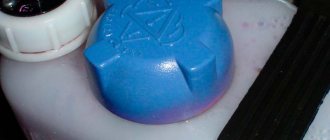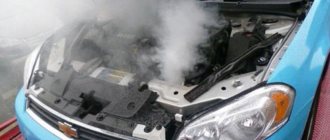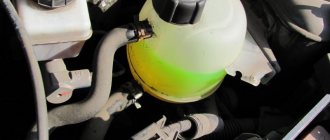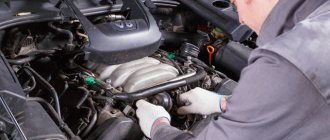Home » Domestic auto industry
1 minute to read. Updated 08/04/2019
1200 rub. for the photo report
We pay for photo reports on car repairs. Earnings from 10,000 rubles/month.
Write:
A breakdown of the cylinder head gasket leads to such unpleasant consequences as engine overheating, poor operation of the stove, the appearance of exhaust gases from under the hood of the car, the appearance of an emulsion in the engine oil, the appearance of white smoke from the exhaust pipe and some others. If the above symptoms or one of them appear, you need to check the cylinder head gasket. There are several ways to do this. Next, we will look at why the cylinder head gasket breaks, what consequences this leads to, and what to do if this trouble happens to your car’s engine.
First of all
Try replacing the cover with a new one or using a known working one for the duration of the test.
Notice how much the tank swells. If it is not significant and it is clear that it is not due to excess pressure, and you are the owner of a VAZ 2110-12, then you should not worry too much, since this is considered the norm for such cars.
The fact is that new tanks for such cars have a finless design and are made of plastic, which does not hold its shape very well, so over time they begin to swell.
Expansion tanks from Lanos, Priora, Nexia have proven themselves well; they are often installed instead of VAZ ones.
If the tank swells strongly and ruptures, even after replacing it along with the lid, then pay attention to the following points:
- Does the coolant boil?
- What color is the oil in the engine crankcase?
- Are there gases from the combustion chamber in the tank?
- What is the pressure in the cooling system;
- The quality of the tank itself.
Detecting the cover malfunction
If you notice that the expansion tank in your VAZ-2110 is boiling at normal engine temperature, first check the cap. This can be done using a car compressor with a pressure gauge.
First, disconnect one of the upper thin hoses from the tank. We close its end tightly by bending it. This is necessary so that the coolant does not leak out when we create pressure in the tank. We connect the hose from the pump to the freed fitting and begin pumping. The lid must be tightly screwed on. When the pressure reaches 1.1 kgf/cm 2, listen to the plug. It should begin to hiss, indicating that it is working. If, when the pressure reaches 1.8 kgf/cm2, the lid does not begin to bleed air, you can safely throw it away. Otherwise, the tank will burst in the near future.
If the lid, on the contrary, begins to let air through before it should, throw it away. If the expansion tank in your VAZ-2110 is boiling, this is the reason.
Gases in the expansion tank
The presence of gases in the expansion tank indicates that the cylinder head gasket has burned out, all signs of this problem. This is one of the main reasons why it can become bloated.
Burnout of the gasket could occur due to overheating of the engine, unless, of course, the time for its overhaul has arrived, since it is at 150 - 250 thousand km. mileage the service life of this gasket is calculated.
But there is an important point here - the reservoir will not expand if the valve in the roof is working properly, since excess pressure will still be released, but the engine will overheat. But, if the flow of gases is very strong, then the valve will not have time to release the pressure and the tank will eventually swell and even rupture.
In order to detect the presence of gases in the cooling system, you must:
- Visually inspect the coolant in the barrel with the engine running and make sure there are bubbles or not. If there are bubbles, then the gasket is most likely broken.
- A more accurate method is to use a gas analyzer. The device will accurately indicate the presence of gases.
- Use balloons or similar (well, you get the idea). The ball is placed on the neck of the tank and tied tightly with threads. You need to start the engine when it is cold, before the heated coolant begins to expand greatly. If the product inflates quickly, it means that exhaust gases are entering the cooling system, this is only possible through the cylinder head gasket.
- Check engine compression. If the car's mileage is not very high, then the compression should be normal, since the cylinder-piston group has not yet worn out. But if the cylinder head gasket is broken, the compression meter will show readings below normal.
You can also check in the area of which cylinder the gasket is broken. To do this, you need to supply air under pressure into the cylinder through the spark plug hole, while the tank cap must be removed.
If the cylinder head gasket is broken, bubbles will be visible in the tanks and air hissing.
The pressure in the cooling system is checked using a 3 atmosphere pressure gauge. To do this, you need to make a tee and connect the device to it.
Start the car and observe the readings. Readings of more than 1.5 atmospheres should already be alarming; 2 – not every barrel can withstand it.
Why does antifreeze come through the lid?
If the engine overheats or the expansion tank swells, many inexperienced drivers immediately run to open the lid and are very surprised, and many are frightened, by the antifreeze leaking out under pressure.
We will immediately reassure you - this is normal. The fact is that when the serviceable reservoir cap is closed, a pressure equal to 1.5-2.0 atmospheres is created in the cooling system. Moreover, we all know from physics that the boiling point of any liquid is directly proportional to the surrounding pressure. That is, the higher the pressure, the higher the boiling point.
Therefore, pressure above atmospheric pressure in the cooling system is created specifically so that antifreeze boils not at 100 C (1 atm.), but at 115 C (1.5 atm.) and 120 C (2 atm.).
After the engine is turned off and the lid is opened, the pressure equalization process occurs, the liquid flows from more to less, while it continues to expand, since the engine continues to gain temperature for some time, i.e. the point at which it begins to cool has not yet been passed.
If the antifreeze boils, it means the engine has overheated. In this situation, you do not need to open the lid right away, since the coolant may splash out on your hands and face under pressure - a burn is inevitable. Just in such a situation, when the tank cap is not working, the latter can swell.
Whoever had any life situations, write in the comments. And also ask questions.
Coolant boiling
If antifreeze (antifreeze) boils, make sure:
- Does the radiator fan work and when does it turn on? The sensor may be faulty;
- Is the thermostat working? The coolant constantly moves in a small circle, thereby not cooling;
- Is the pump working?
- Is the cooling system, including the radiator, clogged?
- Is the system airy?
- Is the valve on the lid working properly? Low pressure in the system can cause premature boiling of the antifreeze.
As for airiness, for example, in VAZ 2110, 2111, 2112, from the experience of their operation, the system practically does not become airborne due to its special design.
In other cars, when replacing the coolant, an air lock may end up in the stove and, over time, make itself felt by overheating the engine and burning out the cylinder head gasket. It is important to monitor the instrument readings.
Some useful tips
To prevent a malfunction of the expansion tank from taking you by surprise, follow these recommendations:
- Constantly pay attention to the readings of the coolant temperature sensor. If you find that the permissible values are exceeded, immediately go for diagnostics or check the functionality of the tank yourself.
- At least once a month, inspect the expansion tank when the engine is hot to identify damage.
- Monitor the refrigerant level. Having detected its fall, find and eliminate the cause of the leak.
- If the refrigerant boils in the tank, do not continue driving under any circumstances - this will damage the engine.
- When planning to replace the tank, buy products from trusted manufacturers in specialized stores.
The cooling system reservoir swells and tears along the seams. Replacing the tank cap and the tank itself did not give any results. Could the cause of the tank swelling be due to a leaky cylinder head connection and the cylinder head itself? That is, does the cylinder head gasket itself allow gas pressure to pass into the coolant cavity?
- Strong steam from exhaust 2110 – 5 answers
- The oil sensor came on after replacing the cylinder head in 2110 - 3 answers
- The stove on the VAZ 2110 does not work - 3 answers
- I unscrewed the cylinder head bolts, do I need to change the gasket? – 2 answers
- Is valve adjustment necessary when replacing the cylinder head gasket? – 2 answers
Check with a gas analyzer whether there are gases in the expansion tank.
If the engine is not overheated, then the cylinder head gasket lasts until the engine itself is overhauled (that is, it is approximately 150-250 t.km.).
For gases in the cooling system. If the expansion tank plug is working properly, then it should relieve pressure, that's why it has a valve there in the plug. Bloating occurs due to a faulty valve in the tank plug.
Oil color
If a gray-white emulsion is found in the engine crankcase, it means that coolant has entered the oil, and its level will decrease and the oil level will increase.
This could happen due to a burnt-out cylinder head gasket, but this is not a fact; additional diagnostics need to be carried out here.
As a rule, first the cap is changed, then the reservoir, and only then, if the latter still inflates, the cylinder head gasket, if necessary. But it is important to understand that you need to replace the cover with a known good one, now a lot of defective ones are produced.
Antifreeze and its properties: what you need to know
Antifreeze is a name given to coolants that have a low freezing point. They consist of varying proportions of water and a concentrate (for example, ethylene glycol or propylene glycol, the latter being more expensive but less toxic). Antifreeze is a Soviet trademark, but in fact it is a separate type of antifreeze.
Initially, the engines were cooled with water, but it had to be abandoned due to a number of properties: low boiling point (100°C), volume expansion in cold weather when freezing, as a result of which the block and engine head crack and this leads to expensive repairs or replacement of elements.
Antifreeze, compared to water, has a higher boiling point and a lower freezing point. When using antifreeze, the extreme boiling point ranges from 108 to 125 °C. The reason for this run-up is the different composition, which also affects the quality of coolants. The lower their price, the lower the boiling point becomes. Especially low-quality antifreezes boil already at 85°C. It is quite obvious that it is not advisable to save when purchasing, since the proper operation and service life of the engine depend on the quality of the coolant.
It is important to remember that even temperature-resistant antifreezes boil for one reason or another. Let's look at the main reasons for antifreeze (antifreeze) boiling.
Checking the quality of the tank
To do this, you need to plug the drain hole in the tank, tighten the caps tightly and connect a pressure gauge to the circuit. Air is supplied under pressure by a compressor.
During the test, it is checked what pressure the tank holds and at what stage the valve operates.
Algorithm of work when sealing cracks in a tank with your own hands
Many car owners are interested in how to seal cracks and crevices in a plastic container. To repair the resulting defect, the following operations must be performed:
- thoroughly clean the plastic from any remaining antifreeze at the crack site using a napkin;
- degrease the welding site with solvent or acetone and dry;
- cut a strip of metal mesh made of brass, consisting of small cells, at least 10 mm wide of the corresponding length;
- apply a mesh patch to the joint being sealed;
- evenly, in several approaches, solder the mesh to each edge of the joint, fusing the plastic with the metal and forming a reinforced layer over the entire area of the patch;
- grinding the resulting connecting seam;
- putty, primer and painting of the welding area.
To carry out soldering, use a soldering iron with a flat tip with a power of at least 40 W. Precise execution of each item of repair measures allows you to completely restore the strength and reliability of the body part.
This product has high heat resistance and resistance to oily liquids. Before applying the polyadhesive to the defect site in the plastic case, it is necessary to carry out careful preparatory operations to clean, degrease and remove traces of substances used previously.











